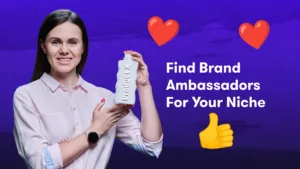How To Find Brand Ambassadors For Your Niche [Turn Your Fans Into Champions]

Brands need people on their side – individuals willing to go out of their way to support their cause online and in person.
But where can you find these people? It’s not always obvious.
You might see some users talking about your brand positively on social media. But are they the right choice?
Fortunately, this post has answers. We look at how to get brand ambassadors for your brand and keep them.
![How To Find Brand Ambassadors For Your Niche [Turn Your Fans Into Champions]](https://billo.app/wp-content/uploads/2024/08/find-brand-ambassadors-1-1024x684.jpg)
The Benefits Of A Robust Ambassador Program
But before we get started, it’s worth exploring why you might want to initiate a brand ambassador program. What’s in it for you?
The primary benefit of brand ambassador search for young companies and startups is the amplification of your voice. Leveraging brand ambassadors gets your message in front of more people.
Establishing a network of ambassadors assists in building authentic connections with your audience. Familiar faces stand behind your products and services, establishing an emotional connection with followers. Customers feel you are reaching out to them on a deeper level than if you relied on slick corporate messaging alone.
Furthermore, because there is more of a conversation, there’s an opportunity to gain valuable insights about what customers want. Ambassadors are more likely to engage in two-way conversations with them, getting to the root of their pain points and issues.
Finding Brand Ambassadors For Your Niche: Tips And Tricks
![How To Find Brand Ambassadors For Your Niche [Turn Your Fans Into Champions]](https://billo.app/wp-content/uploads/2024/08/find-brand-ambassadors-3-1024x683.jpg)
So, how can you go about finding brand ambassadors for your niche?
Write Down Your Ideal Brand Advocate
First, write down your ideal brand ambassador. This person won’t exist in reality. However, describing them can help create a profile for them so you know who to target in your recruitment campaign.
The perfect candidate should embody your brand’s values and messaging and their attitude should match what you stand for (or get close to it).
Don’t go looking for brand ambassadors with different opinions or ethics from you. Disparities could damage your brand and leave you worse off.
Brand ambassadors should also share a similar target audience as you. You want partners who can expand your outreach to high-quality leads instead of irrelevant third parties.
Other characteristics you want include:
- Individuals who genuinely love your brand and want to support you (perhaps because they’ve enjoyed your products and services in the past)
- Ambassadors who have large, relevant audiences and are willing to share brand-related content with them
- Ambassadors who understand how your brand operates and your commercial goals
Usually, finding ambassadors with similar audiences is fairly straightforward – just search for those posting in your niche. However, it’s harder if your products or services don’t fit well into established categories.
Focus on finding complementary ambassadors in these cases whose audiences care about what you want to sell.
Choose Outreach Strategies To Find Brand Champions
Once you have a decent idea of your ideal brand ambassador, the next step is to reach out to them. But how should you do that?
The best approach is to identify ambassadors via social media. Influencers and commenters often promote brands they love to their followers and other users.
The data backs this up. Ninety-three percent of influencers are willing to work with brands for free as long as they love the product, so the cost is usually low. Nevertheless, you can still offer a commission to incentivize them if it would help.
Another less-used strategy is to find brand ambassadors at physical events and gatherings. These can be useful when you operate in an industry that relies on referrals.
You can also engage regular customers (perhaps ones who left positive reviews) to become ambassadors. Many will be willing to help you if they believe in your product and can get referral rewards.
When reaching out to brand ambassadors, hit them with a compelling call to action. Encourage them to take the next step by promising them something tangible. For example, you might say something like “Sign up today and start earning commission immediately” or “Sign up to get a special audience discount code.” Treating them like regular users can help get the ball rolling.
Design Your Application Process
Next, design a robust application process to ensure only people who love your brand can represent you. The best way to do this is with an online form. You could include fields covering:
- Basic information (such as their name and address)
- Their love of your products/services and why they want to champion you
- Data relating to your content creation skills (perhaps from previous posts)
- The ability to use marketing and outreach tools to get their message heard
- How much time do they have available to dedicate to your brand (most prospective ambassadors will have full-time jobs or commitments to other companies)
You can also reach out to brand ambassadors in person. Connecting with people in this way lets you gather the same information you would on the form. However, it also makes the interaction more personal and shows them you care about working with them.
Send prospective ambassadors emails acknowledging their interest in working with you if they apply. Tell them how long the selection will take and when you will talk to them again – usually one to two weeks.
During this effort, also ensure you have adequate selection criteria in place. Know what you want from your ambassadors (and what you don’t).
Some brands allow anyone and everyone to work with them. However, most companies benefit most by being selective. After all, partners are risky and could pollute your brand if you get the selection wrong.
Onboard And Equip Your Brand Ambassadors
After you decide on the new ambassadors you want to work with, it’s time to onboard and equip them. But how can you do that effectively?
Start with an impressive introduction, telling brand ambassadors about the perks of working with you. Pitch ambassadorship as being a member of an exclusive club – something only a minority of people are part of. (For example, your brand might only have 200 people on its internal newsletter email list).
Next, provide ambassadors with program guidelines – what they need to do to represent your brand in the best possible light. For example, you might instruct them to:
- Review your products on your website to ensure they understand them
- Follow the marketing strategies you outline
- Respond to customer queries in specific ways on social media
- Add your brand’s tone of voice into their outreach efforts
- Provide balanced advice to customers
Issuing a list of instructions reduces the risk of brand damage and lets ambassadors know how they should represent you. Remember, many of them won’t have done any marketing or social media outreach before and will need clear guidelines on how to proceed.
Finally, always provide ambassadors with plenty of resources and support on how to be a brand ambassador. Giving them the tools they require to succeed helps them promote you online, increasing your return on investment.
The tools you provide depend on your niche and could include:
- Product demo videos showing ambassadors and micro-influencers the proper way for customers to use what you sell
- Information regarding your brand story and mission so influencers can relay these data to their audiences
- Frequently asked questions running through the most common queries (so ambassadors don’t take up your team’s time)
- Brand assets like digital files containing your logos and templates
- Ambassador discount coupons or codes for extra money off products online
- Brand portals where ambassadors can access the materials they require from a single location
- Mentorship program to help brand ambassadors work more effectively on behalf of your organization
- Check-ins and meet-ups to help them feel like part of the community
- Webinars to speak to executives and other brand leaders about strategy and direction
- Performance-related tools to see commission and bonuses earned over time
- Templates for blogs, social media posts, and web pages to improve brand recognition
Don’t feel restricted to this list, though. If you can think of another way to support your brand ambassadors cost-effectively then do.
Build Loyalty And Engagement
![How To Find Brand Ambassadors For Your Niche [Turn Your Fans Into Champions]](https://billo.app/wp-content/uploads/2024/08/find-brand-ambassadors-2-1024x683.jpg)
Once ambassadors are working for you, sales should transform from a trickle to a torrent. However, proceeding cautiously is still essential: your highest-performing ambassadors could leave at any time.
The simplest (and cheapest) way to retain people is to maintain communication with them. Setting up a weekly email schedule or call-in keeps them up-to-date and makes them feel involved.
During communications ensure you keep them apprised of everything they need to know. Talk about program updates and brand news, including any exciting new initiatives you want to explore. Help them with content inspiration and guidance if they can’t think of new angles.
Make sure you leverage the power of recognition, too. Organizations with robust recognition programs in place experience a voluntary 31% lower turnover rate.
When delivering recognition, offer a combination of public praise and exclusive incentives. For example, mention them in your upcoming newsletter and give them an extra 15% on top of their existing commission.
At the same time, ensure you dedicate some of the interaction to a question-and-answer session. Give brand ambassadors the space to ask relevant questions and get ideas off their chest. Engaging in two-way conversations makes them feel loved and appreciated.
Finally, encourage ambassadors to generate content themselves. Put them to work on interesting projects that motivate them.
You could do this by:
- Providing them with a content calendar and getting them to fill in the blanks
- Developing a brand asset library containing images, video, and other materials they can use to create pieces to share with their audiences quickly
- Setting up ambassador groups on social media where they can share their latest ideas and get feedback on their published work
- Offering incentives and performance-based rewards to encourage them to spend more time developing and generating content
- Rating one ambassador as “ambassador of the month” based on their performance metrics
- Encouraging ambassadors to tailor their content to their audiences’ unique requirements and styles
Ambassadors can sometimes run hot and cold because they are not regular employees. Therefore, encouraging activities like these are essential. Supporting your brand should feel intrinsic and something your partners want to do naturally. The more ambassador-generated content you can create, the better.
Measure Your Success
The last step brands looking for ambassadors use is measuring their success. After all, running these campaigns can be expensive.
To do this, you can leverage relevant key performance indicators (KPIs). These should reflect the goals of your campaign. Suitable metrics include:
- The number of sales ambassadors generate (via their codes)
- The average order value (and whether it increases when it comes through an ambassador)
- Click-through rates on ambassador content
- Mentions in the media generated by ambassador activities
- Growth in the number of people following you on social media
- The amount of website traffic you are receiving
- The cost per acquisition (how much it costs you to bring in a new customer via the ambassador program)
Fortunately, you don’t need to collect these metrics by hand (an impossible task). Software tools can do it for you.
Decent tools include:
- Google Analytics for website analysis (and seeing where your customers come from)
- Google Forms (for creating forms you can use for surveys)
- Hootsuite for tracking the performance of brand ambassador content on social media
You can also get specific brand ambassador management software to make harnessing a large group of people easier. These let you do things like track content creation and analyze ambassador performance. You also get various tracking tools to see how they performed and what level of relationship it is worth having with them.
Basic programs don’t always require tools – sometimes you can use in-built functionality on Google and social media. However, more complex initiatives may require dedicated solutions.
Numerous brands have successful ambassador programs in place you can emulate. For example, Microsoft’s Xbox built one of the best campaigns in history when it faced stiff competition from PlayStation and Nintendo in 2001. The company saw the future of gaming was online, so it encouraged fans to join its team and make experiences more fun for everyone by building a community.
Incredibly, that happened and now Xbox offers more support than any other console. Gamers participate in designing and creating new titles along with developers and engineers.
Continue learning:
How To Use Long-Term UGC Creator Partnerships To Unlock Authenticity And Brand Loyalty
Influencer marketing is taking off. However, many brands still believe [...]...
Read full articleBrand Ambassador vs Affiliate Marketing: Which Is The Best Strategy For Leveraging UGC?
Generating user-generated content (UGC) for brand marketing campaigns makes sense. [...]...
Read full articleUsing Influencer Marketing Reporting For Success [Decoding The Data]
Influencer marketing is among the most successful strategies ever invented [...]...
Read full article

